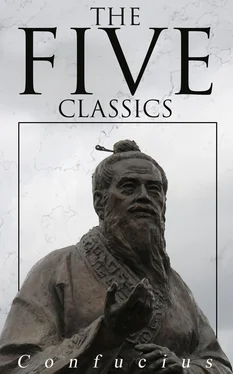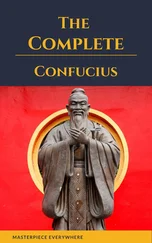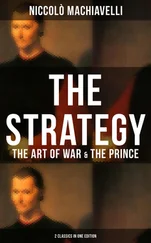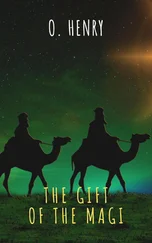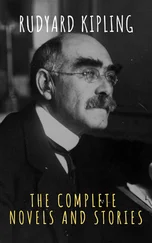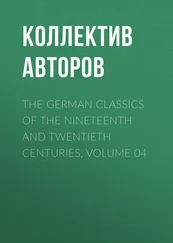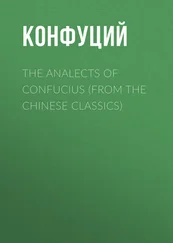The other parts of the body, such as the mouth, eyes, and ears, have their appetencies, which lead them to what is without themselves. The back alone has nothing to do with anything beyond itself-hardly with itself even; all that it has to do is to stand straight and strong. So should it be with, us, resting in principle, free from the intrusion of selfish though s and external objects. Amidst society, he who realises the idea of the hexagram is still alone, and does not allow himself to be distracted from the contemplation and following of principle. He is not a recluse, however, who keeps aloof from social life; but his distinction is that he maintains a supreme regard to principle, when alone, and when mingling with others.
In the symbolism the author rises from one part of the body to the other. The first line at the bottom of the figure fitly suggests 'the toes.' The lesson is that from the first men should rest in, and be anxious to do, what is right in all their affairs. The weakness of the line and its being in an odd place give occasion for the caution, with which the paragraph concludes.
Above the toes are the calves, represented by the second line, weak, but in its proper place. Above this, again, are the loins, represented by 3, strong, and in danger of being violent. Line 2 p. 178 follows 3, and should help it; but is unable to do so; and there results dissatisfaction.
When the calves are kept at rest, advance is stopped, but no other harm ensues. Not so when the loins are kept at rest, and unable to bend, for the connexion between the upper and lower parts of the body is then broken. The dissatisfaction increases to an angry heat. Paragraph 3 is unusually difficult. For 'loins' P. Regis has scapulae, and for ribs renes; Canon McClatchie says:--'Third Nine is stopping at a limit, and separating what is in continued succession (i. e. the backbone); thus the mind,' &c.
Line 4 is a weak line resting in a proper place; hence it gives a good auspice. The Khang-hsî editors, however, call attention to the resting of the trunk as being inferior to the resting of the back in the Thwan.
The place of the weak fifth line is not proper for it; and this accounts for the mention of its subject 'repenting,' for which, however, there is not occasion.
The third line of the trigrams, and the sixth of the hexagram, is what makes Kăn what it is,--the symbol of a mountain. The subject of it therefore will carry out the resting required by the whole figure in the highest style.
Table of Contents

K ien suggests to us the marriage of a young lady, and the good fortune (attending it). There will be advantage in being firm and correct.
1. The first line, divided, shows the wild geese gradually approaching the shore. A young officer (in similar circumstances) will be in a position of danger, and be spoken against; but there will be no error.
2. The second line, divided, shows the geese gradually approaching the large rocks, where they eat and drink joyfully and at ease. There will be good fortune.
3. The third line, undivided, shows them gradually advanced to the dry plains. (It suggests also the idea of) a husband who goes on an expedition from which he does not return, and of a wife who is pregnant, but will not nourish her child. There will be evil. (The case symbolised) might be advantageous in resisting plunderers.
4. The fourth line, divided, shows the geese gradually advanced to the trees. They may light on the flat branches. There will be no error.
5. The fifth line, undivided, shows the geese gradually advanced to the high mound. (It suggests the idea of) a wife who for three years does not become pregnant; but in the end the natural issue cannot be prevented. There will be good fortune.
6. The sixth line, undivided, shows the geese gradually advanced to the large heights (beyond). Their feathers can be used as ornaments. There will be good fortune.
53. K ien is ordinarily used in the sense of gradually; but there is connected with that the idea also of progress or advance. The element of meaning in the character is the symbol of water; and the whole of it denotes gradual advance, like the soaking in of water. Three hexagrams contain in them the idea of advance, Ȝin (35), Shăng (46), and this K ien; but each has its peculiarity of meaning, and that of K ien is the gradual manner in which the advance takes place. The subject then of the hexagram is the advance of men to offices in the state, how it should take place gradually and by successive steps, as well as on certain other p. 180 conditions that may be gathered from the Text. P. Regis gives this exposition of the subject, as taken by him from the symbolism, which he ascribes to Confucius:--'Viri probi, seu republica digni, in virtutis soliditate instituendi sunt a sapiente, bonisque regulis ut altis radicibus firmandi, nec alii ad rempublicam tractandam promovendi, nisi qui paulatim per varios minoresque gradus ad magnum hoc regimen periculo facto ascendere digni sint.' He then illustrates this sentiment by the words of Pliny:--'Eligetur multis experimentis eruditus, et qui futura possit ex praeteritis praevidere.'
But how does the lineal figure give the idea of a gradual advance? We shall see how it is attempted in the Great Symbolism to get this from the component trigrams. The account there is not satisfactory; and still less so is what else I have been able to find on the subject. E. g., the trigrams were originally Khwăn and Kh ien; but the third line of Khwăn and the first of Kh ien have changed places; and the trigrams now denote 'the youngest son,' and 'the eldest daughter.' If all this, which is a mere farrago, were admitted, it would not help us to the idea of an advance.
Again, the lines 2, 3, 4, 5 are all in the places proper to them as strong or weak; we ascend by them as by regular steps to the top of the hexagram; and this, it is said, gives the notion of the gradual steps of the advance. But neither does this carry conviction with it to the mind. We must leave the question. King Wăn, for reasons which we cannot discover, or without such reasons, determined that the hexagram K ien should denote the gradual advance of men to positions of influence and office.
The marriage of a young lady is mentioned in the Thwan as an illustration of an important event taking place with various p. 181 preliminary steps, continued from its initiation to its consummation. But all must he done in an orderly and correct manner. And so must it be with the rise of a man in the service of the state.
The goose from the most ancient times played an important part in the marriage ceremonies of the Chinese; and this may have suggested the use of it in the symbolism of the different lines. Its habits as a bird of passage, and flying in processional order, admirably suited the writer's purpose. In paragraph 1 it appears for the first time in the season approaching the shore. Then comes the real subject of the line; and the facts of its being weak, and without a proper correlate, agree with, if they do not suggest, what is said about him, and the caution added.
The geese have advanced in line 2, and so has the officer, though he is not mentioned. The line is weak or humble, and central, and has a proper correlate in 5. Hence comes the good auspice.
Line 3 is strong, and has passed the central place, to the top of the lower trigram, and has not a proper correlate in 6. Its subject is likely to be violent and at the same time unsuccessful in his movements. He is like a husband who does not care for his wife, or a wife who does not care for her child. But in the case supposed, his strength in the end would be useful.
Читать дальше
